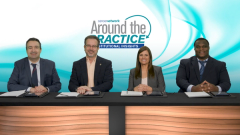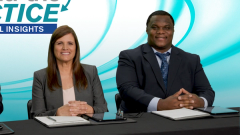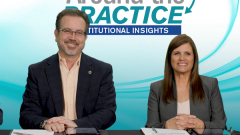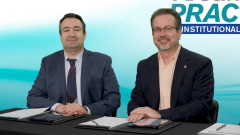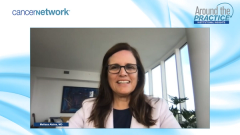
Selecting First-Line Therapy for Patients With Transplant-Ineligible NDMM
Moving on to review the management of transplant-ineligible NDMM, expert panelists highlight first-line treatment options with data from the SWOG0777 and MAIA studies.
Episodes in this series

Transcript:
Melissa Alsina, MD: We’ll proceed with module 2 of our discussion, and this is going to focus on translating evidence to practice to improve outcomes in patients with newly diagnosed myeloma that are transplant ineligible. Dr Baz, I will start with you. Can you talk to us about what are the available first-line treatment therapies for patients that are transplant ineligible?
Rachid Baz, MD: Yes. The standard of care for patients who are transplant ineligible is derived from largely 2 studies, the SWOG S0777 [NCT00644228]study and the MAIA [NCT02252172] study. The SWOG study compared 6 months induction with VRd [Velcade (bortezomib) plus Revlimid (lenalidomide) and dexamethasone] vs Rd [lenalidomide and dexamethasone], and then everybody received lenalidomide/dex [dexamethasone] maintenance. The SWOG study demonstrated that the addition of 6 months of bortezomib to induction improved PFS [progression-free survival] by about 11 months, and it improved the median survival by about 11 months. So it’s very powerful data that adding bortezomib for a defined time frame of 6 months, and then it became nearly a year in terms of median overall survival and PFS. In addition, the MAIA study is slightly different in design. It compared daratumumab [Darzalex], lenalidomide, [and] dex [dexamethasone] to the lenalidomide/dex [dexamethasone]. The patients received continued lenalidomide and daratumumab in the experimental arm vs lenalidomide-based maintenance. The MAIA study was very interesting in the sense that the overall response rate was very high, 92%. So quite a bit elevated, and this is, even the comparator arm already had a better response rate than what we saw in the SWOG study with the comparator arm Rd. And the PFS that we have seen with the MAIA study is now in excess of 60 months. The PFS is nearly doubled by the addition of daratumumab. And what’s fascinating about this is that this doesn’t, daratumumab adds, really doubles the PFS, improves survival, but at the cost of literally in terms of additional toxicity to lenalidomide. Now the design differences make it really hard to compare those 2 studies as we’ve seen the comparator arm has not had the same outcomes. But really that sets the stage. Right now, we need a standard of care for patients who are transplant ineligible, which would be either a VRd-lite type regimen or Dara [daratumumab]/Rd as in the MAIA study. And finally, really the SWOG study, it has to be said, was not truly a transplant-ineligible study, actually, 3 quarters of the patients who are considered to be transplant ineligible just had to defer transplant. So that really sets the stage of where we’re at currently in practice, and we have to decide between the VRd-lite approach or the Dara [daratumumab]/Rd type of approach.
Melissa Alsina, MD: So how do you decide between those approaches? Ken, what do you do in your practice?
Ken Shain, MD, PhD: Yeah. Great question. Right now, I think again, caveats as Rachid had pointed out is that these studies are actually done at different times. They’re different patient populations, and you can’t compare head-to-head, but the daratumumab, lenalidomide, dexamethasone vs Len [lenalidomide]/dex [dexamethasone] is really profound data. Five-plus years of PFS, as an average for the DRd [daratumumab and lenalidomide plus dexamethasone] arm, so it’s a great number. And then overall survival has not been met yet, whereas, in the Rd arm, you have met a survival. Those are things that you think this is what I should do for everybody. OK. But there are definitely things we don’t know yet. And I think historically I’ve thought, and really talked a lot about how proteasome inhibitors are really important for maintaining the high-risk patient population and maintaining the control of those individuals over time. So what I would tell you, as a patient walks into my clinic, what I am going to do is I’m going to say, DRd for anybody who’s a standard risk, OK. And then I am only thinking about VRd, or bortezomib, lenalidomide, [and] dexamethasone in a lite fashion. There are enough studies out there demonstrating that we don’t have to give it dose density individuals, that really should be weekly bortezomib, lenalidomide 1 through 21, dex [dexamethasone] weekly, 20 milligrams, only over a course of 4 weeks. That’s how I think about a high-risk patient when they walk in. It’s like, kind of how I decide which one of these I’m going to use. But again, there are patient factors you need to think about. Do they have neuropathy? Do they have this? Or how easy is it going to be? Because Dara [daratumumab] becomes incredibly friendly dosing because it ends up being once a month. [That’s] all they’re going to get. So you have to take into [consideration] a few other things, other than just risk, etc. When I see a patient that’s what I’m thinking about when I’m making the first decision before I layer in these other things we need to think about.
Melissa Alsina, MD: OK.
Rachid Baz, MD: I think I would add, though, that maybe not all high-risk patients are the same, and not all high-risk really necessarily benefit from bortezomib vs daratumumab. I make the argument certainly for the t (4;14) translocation patients, that I will include, bortezomib or proteasome inhibitor. But maybe for the other high-risk patients, I think that Dara [daratumumab]/ Rd would be really reasonable. I think it’d be really interesting to kind of hear Brandon’s perspective on how he incorporates frailty into their assessments because I think we don’t have a lot of data with really frail elderly for the VRd backbone. Or the VRd-lite backbone has been tested in patients who are frailer, but we don’t have really strong data in terms of efficacy, comparing it to anything else, really. So I would be interested in your thoughts about the frail patients and how we would consider that discussion.
Brandon Blue, MD: I think first of all, how do we define frail? I think that’s 1 of the big problems when it comes to myeloma care. Myeloma is already a disease of an aging population. And then the first decision that we’re trying to make for these patients is, do they need a transplant or not? How strong are they? Unfortunately, some of the time that is actually related to the disease itself because the disease can be very crippling. And so what this patient was like, maybe 3 to 6 months prior to this diagnosis, it’s not like who’s actually sitting in front of you. So it may be a misrepresentation of the patient’s actual functional status. But I do think that it’s important for us to take that into consideration because our first job as physicians is to do no harm. And unfortunately, some of the medications that we use can lend people to be wheelchair-bound and really impair their quality of life. We’ve already talked about multiple myeloma not being curable cancer. So really quality of life is something that should be of the utmost priority for us. I would say that based on the data and some of the research that I’ve seen, that really when it comes down to some of the minimal side effect profiles, then medications that have a daratumumab backbone really seemed to not only be very efficacious but also very minimal toxicities. And so I think that if you’re really trying to maximize kind of an upfront approach for a patient, you say well there are 2 things that I want. I want the patient to actually respond, and I want the patient to actually tolerate it. Because a patient, no matter how well it works, if they can’t actually get the medicine that you want to give them, unfortunately, you’re not doing a great job. And so I think that those are 2 things that I really look for. And that’s my approach.
Rachid Baz, MD: Yeah. I completely agree.
Transcript edited for clarity.
Newsletter
Stay up to date on recent advances in the multidisciplinary approach to cancer.


